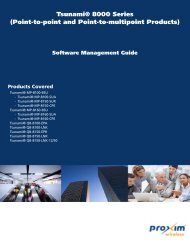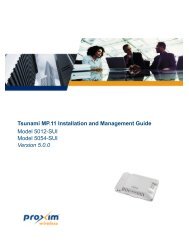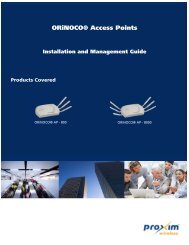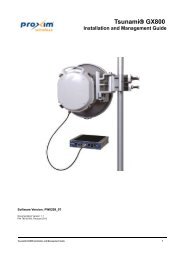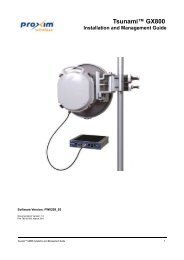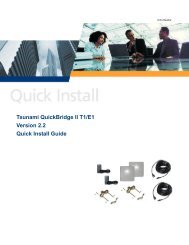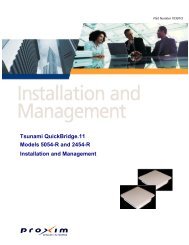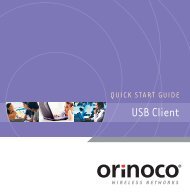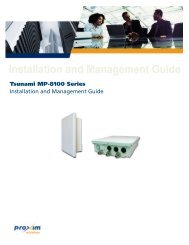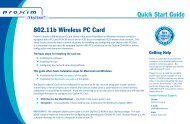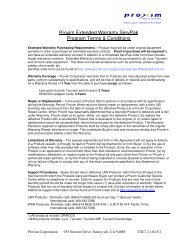Tsunami MP.11 Installation and Management Model 5012-SUR ...
Tsunami MP.11 Installation and Management Model 5012-SUR ...
Tsunami MP.11 Installation and Management Model 5012-SUR ...
You also want an ePaper? Increase the reach of your titles
YUMPU automatically turns print PDFs into web optimized ePapers that Google loves.
Configuration <strong>Tsunami</strong> <strong>MP.11</strong> <strong>5012</strong>-<strong>SUR</strong> <strong>Installation</strong> <strong>and</strong> <strong>Management</strong><br />
Interface Parameters<br />
• Frequency Channel: The frequency channel indicates the b<strong>and</strong> center frequency the unit uses for communicating<br />
with peers. This frequency channel can be set in several ranges, depending upon regulatory domain. Refer to Country<br />
Codes <strong>and</strong> Channels for channelization information. For countries in which DFS is not required, the Frequency<br />
Channel list displays only the channels <strong>and</strong> frequencies allowed for the selected country.<br />
For countries in which DFS is required, Frequency Channel is not configurable. Instead the channel is auto-selected<br />
by the DFS process.<br />
If All Channels 5 GHz is selected in the Country drop-down menu on the Configure > System page, any channel in<br />
the 5 GHz range is manually selectable.<br />
• DFS Backup Channel Status: This field appears only if a US-DFS Country is selected from the Configure >System<br />
page. The device operates in channel 149 when all channels are blacklisted.<br />
• Scanning Across B<strong>and</strong>width: Enable this field if you want the SU to scan across the whole range of channel<br />
b<strong>and</strong>widths (5, 10, or 20 MHz, as available) with or without roaming enabled. Disable this field if you wish the SU to<br />
scan only across its configured channel b<strong>and</strong>width when roaming enabled.<br />
• Multicast Rate: The rate at which data is to be transferred. All RF traffic between <strong>5012</strong>-<strong>SUR</strong> units is multicast. This<br />
drop down box is unavailable when DDRS is enabled.<br />
The default data rate for the <strong>5012</strong>-<strong>SUR</strong> is 36 Mbps. The SU must never be set to a lower data rate than the BSU,<br />
because timeouts will occur at the BSU <strong>and</strong> communication will fail.<br />
Selections for multicast rate are shown in the following table:<br />
5 MHz 10 MHz 20 MHz 40 MHz (TurboMode)<br />
(US Non-DFS <strong>and</strong> All Channel -<br />
5GHz(A5) Only; 5054-R only)<br />
1.5 3 6 12<br />
2.25 4.5 9 18<br />
3 6 12 24<br />
4.5 9 18 36<br />
6 12 24 48<br />
9 18 36 72<br />
12 24 48 96<br />
13.5 27 54 108<br />
• Channel B<strong>and</strong>width: This field is used to change the b<strong>and</strong>width. Values are 5 MHz, 10 MHz, or 20 MHz, as well as<br />
40 MHz when Turbo mode is enabled.<br />
NOTE: The 5 MHz channel b<strong>and</strong>width is not available when the selected country is UNITED STATES DFS.<br />
• Satellite Density: The Satellite Density setting is a valuable feature for achieving maximum b<strong>and</strong>width in a wireless<br />
network. It influences the receive sensitivity of the radio interface <strong>and</strong> improves operation in environments with a high<br />
noise level. Reducing the sensitivity of the unit enables unwanted “noise” to be filtered out (it disappears under the<br />
threshold).<br />
You can configure the Satellite Density to be Large, Medium, Small, Mini, or Micro. The default value for this<br />
setting is Large. The smaller settings are appropriate for high noise environments; a setting of Large would be for a<br />
low noise environment.<br />
A long distance link may have difficulty maintaining a connection with a small density setting because the wanted<br />
signal can disappear under the threshold. Consider both noise level <strong>and</strong> distance between the peers in a link when<br />
configuring this setting. The threshold should be chosen higher than the noise level, but sufficiently below the signal<br />
level. A safe value is 10 dB below the present signal strength.<br />
If the Signal-to-Noise Ratio (SNR) is not sufficient, you may need to set a lower data rate or use antennas with higher<br />
gain to increase the margin between wanted <strong>and</strong> unwanted signals. In a point-to-multipoint configuration, the BSU<br />
should have a density setting suitable for all of its registered SUs, especially the ones with the lowest signal levels<br />
(longest links).<br />
75





